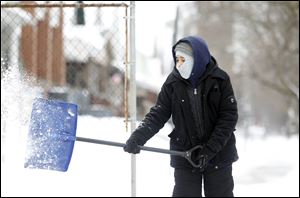
Horrible winter is likely for Toledo
10/6/2011
Paul Espino, 11, bundles up to shovel the walkway at his home on the corner of Jay and Clark in east Toledo in this Feb. 1, 2011, file photo.
The coming winter season could easily be one of the top 10 worst in Toledo history, according to AccuWeather Inc., the private weather forecasting service based in State College, Pa.
The infamous season of the Blizzard of 78 was the snowiest at 73.1 inches.
"It wouldn't be a stretch to say we could reach the bottom" of the top 10, said Bob Smerbeck, AccuWeather expert senior meteorologist.
The 10th snowiest winter was 100 years ago, 1911-12, at 51.9 inches.
In fact, this winter is going to be very bad in the upper Midwest and upper Great Lakes with bitter temperatures and heavy snow everywhere.
For snow and cold, this winter is expected to be the worst in Chicago, AccuWeather predicted.
"People in Chicago are going to want to move after this winter," said Josh Nagelberg, AccuWeather long-range meteorologist.
"Some places will have heavy snow, and some places will be really cold," Mr. Smerbeck said.
The worst of it will be in the northern Plains, plus Iowa, Minnesota, Wisconsin, northern Illinois, and parts of western Michigan.
"You guys are on the edge of that [in Toledo]," Mr. Smerbeck said.
Being on the edge will mean above normal snowfall and precipitation from December through February and temperatures slightly below normal, he said.
"It could be an active winter for Toledo and southeast Michigan," Mr. Smerbeck said.
In the area more recently, the eighth and seventh snowiest seasons were -- 56 inches in 2004-05 and 56.4 inches in 2002-03.
The average snowfall in a season is 37 inches in Toledo.
February, 2012, could be a pleasant contrast -- relatively -- to that month the year before, which was the snowiest February in Toledo since record-keeping began in 1873.
"A lot of our computer models are showing moderation when we get to February," Mr. Smerbeck said.
But that's nearly a season away.
"[We] might jump into winter quickly, by mid-November," Mr. Smerbeck said. "We think the early part of winter we're going to have some pretty chilly air masses coming down out of Canada."
AccuWeather, which released its long-range forecast yesterday, blames the Pacific Ocean phenomenon called "La Nina."
For the second consecutive year, cooler temperatures in the eastern Pacific will have a dramatic effect on North America's weather, changing the flow of the jet stream.
And that's why meteorologists can issue such a long-range look.
"These ocean signals, they don't change on a dime," Mr. Smerbeck said. "Once they build, it takes a while to break down."
AccuWeather's meteorologists consult tropical events, upper-atmospheric disturbances, and equatorial Pacific Ocean temperatures.
The winter will see its share of swift-moving clippers and cutters, AccuWeather meterologists said, roaring down from Canada, rocketing over the Great Lakes and out to the Atlantic Ocean.
Weather patterns this coming winter should spare the major storms that gripped the northeast last year, with few significant snow or ice storms, AccuWeather forecasts.
The AccuWeather forecasts are somewhat at odds with the venerable publication, The Old Farmer's Almanac, which has been printing since 1792. This year's edition predicts slightly milder than normal, on average, in Toledo, with the coldest periods in late November, mid-December, late January, and early and mid-February.
Farmer's Almanac spokesman Ginger Vaughan said the forecast is cobbled together from solar science, modern technology, and a "secret formula" locked in a black box beneath the editor-in-chief's desk.
Asked whether she was surprised that AccuWeather's temperature forecast was the opposite of the almanac's, Ms. Vaughan said frostily, "I really don't have a comment either way."
Information from The Blade's sister paper, the Pittsburgh Post-Gazette, was used in this report.
Contact Mark Zaborney at: mzaborney@theblade.com or 419-724-6182.